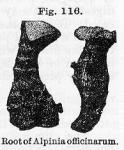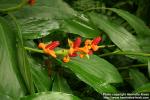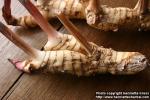Galanga.—Galangal.

 Preparation: Fluid Extract of Galangal
Preparation: Fluid Extract of Galangal
The rhizome of Alpinia officinarum, Hance.
Nat. Ord.—Scitamineae (Zingiberaceae).
COMMON NAMES: Colic root, East India root, Galangal.
ILLUSTRATION: Bentley and Trimen, Med. Plants, 271.
Botanical Source and History.—The plant that yields galangal was described by Mr. H. F. Hance, in the Journal of the Linnéan Society (1871). The plant was obtained from Hainan, an island directly south of China, but it also doubtless grows on the adjacent mainland, as the root is largely exported from Shanghai and other China ports. The galangal of commerce is known as Lesser galangal;  another variety known as Greater galangal, is rarely found in the market. It is the product of Alpinia Galanga Willdenow, (Maranta Galanga, Linné), and grows in Java. The name galangal is said to be derived from the Arabic Khanlanjan, which, in turn, is perhaps the perversion of a Chinese word, signifying mild ginger. Galangal has long been an article of commerce with the Eastern nations, and has been known in Northern Europe since the twelfth century (Hance). The stem is from 2 to 4 feet high, erect, and bears a close resemblance to the common cultivated canna, or shot plant. The parallel-veined leaf blades are about a foot long, 2 to 4 inches wide, smooth, entire, and sharply acuminate. They are attached at the base to a scarious, margined sheath, which clasps the stem. The flowers are borne in a terminal dense spike; they consist of a short, tubular, superior calyx, a white corolla, with 3 lobes, a large ovate labellum marked with red veins, a single anther-bearing stamen, and a pistil with an inferior ovary and a slender style (Bentley and Trimen, Med. Plants).
another variety known as Greater galangal, is rarely found in the market. It is the product of Alpinia Galanga Willdenow, (Maranta Galanga, Linné), and grows in Java. The name galangal is said to be derived from the Arabic Khanlanjan, which, in turn, is perhaps the perversion of a Chinese word, signifying mild ginger. Galangal has long been an article of commerce with the Eastern nations, and has been known in Northern Europe since the twelfth century (Hance). The stem is from 2 to 4 feet high, erect, and bears a close resemblance to the common cultivated canna, or shot plant. The parallel-veined leaf blades are about a foot long, 2 to 4 inches wide, smooth, entire, and sharply acuminate. They are attached at the base to a scarious, margined sheath, which clasps the stem. The flowers are borne in a terminal dense spike; they consist of a short, tubular, superior calyx, a white corolla, with 3 lobes, a large ovate labellum marked with red veins, a single anther-bearing stamen, and a pistil with an inferior ovary and a slender style (Bentley and Trimen, Med. Plants).
Description.—The rhizome, as found in market, is in sections of from 1 inch to 4 inches in length, and of a reddish-brown color, as though covered with rust. The cut ends are usually rounding, while the edges expand outwardly and turn back. Each fragment has, generally, one or more short branches, and it is evident that the roots are taken from the ground in masses, and chopped into pieces. Encircling them at intervals of from ⅛ to ½ inch apart, are corrugated rings of a light color consisting of adhering bases of leaf sheaths. The roots are stout, and break with a granular fracture presenting a brownish-gray color, interspersed throughout which are small ligneous fibers. These fibers project a short distance beyond one surface of the root, thus leaving depressions on the opposite side, resembling pin-holes; the center of the root, for about one-fourth to one-third of its diameter, consists of a bundle of these fibers. Galangal reminds us of ginger, and imparts a pungent taste and an aromatic odor, very similar to that article. In this country, galangal has not come into use among physicians, but has been sold extensively by street-corner venders under such names as "colic root," "the wonderful East India root," etc., and was asserted by them to be a certain cure for toothache, headache, etc.
Chemical Composition.—The constituents of galangal are similar to those of ginger. A volatile oil is obtained by distilling the root with water, which possesses a camphoraceous smell resembling that of cajeput oil. This is due, according to Schimmel & Co. (1890), to the presence of appreciable amounts of cineol. It is soluble in alcohol, and is lighter than water. A soft resin, having a pungent taste, is extracted by ether, and also a peculiar, crystalline substance, named by Brandes (1839), kaempferid. Jahns (1881) differentiated the kaempferid of Brandes into three compounds, all forming yellow crystals, viz., kaempferid (C16H12O6), fusing at 222° C. (431.6° F.), almost insoluble in water, and soluble with difficulty in alcohol; galangin (C15H10O5), fusing at 214° C. (417.2° F.), soluble in 34 parts of absolute and 68 parts of 90 per cent alcohol; and alpinin (C17H12O6), fusing at 173° C. (343.4° F.).
Kaempferid, by oxidation with nitric acid, forms anisic acid (C6H4[OCH3]COOH), oxalic acid and other products. Galangin similarly yields benzoic and oxalic acids (Amer. Jour. Pharm., 1882, p. 288). Kostanecki and Harry M. Gordin (Dissert., 1897), showed kaempferid to be a flavonol derivative and established its exact graphic formula. Probably galangin is similarly constituted. Thresh (Pharm. Jour. Trans., Vol. XV., 1884, p. 234), announced the presence of a pungent principle, which he designated galangol, and gave the tabulated results of a complete analysis of the root, which shows as much as 23.7 per cent of starch.
Action, Medical Uses, and Dosage.—Galangal is a stimulating aromatic, and has been successfully employed to aid the digestive process, preventing fermentation and removing flatus. It will be found especially useful in some forms of dyspepsia, preventing vomiting or sickness of the stomach, and facilitating digestion. It may be used in all cases in which a stimulating aromatic is indicated. It has some reputation as a remedy for perineal relaxation with hemorrhoids, and for a lax and pendulous abdomen. Its best form of administration is in tincture, the dose of which is from ½ to 1 fluid drachm. The powder may be given in doses of 15 to 20 grains; from 30 to 60 grains may be given in infusion. It is rarely prescribed at the present day.

